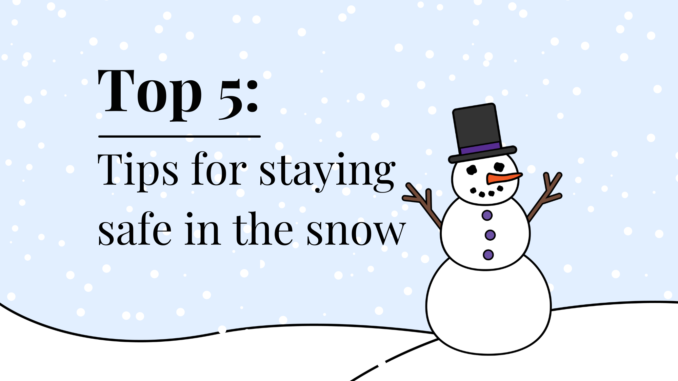
The City of Kirksville issued a snow emergency for Feb. 1 in preparation for winter weather to hit the city. The National Weather Service issued a winter storm watch for Feb. 1 through Feb. 3, predicting heavy snow and accumulations of 6 to 14 inches during that time. As someone who has weathered my fair share of Kirksville winters, I thought I would share some of my tips on how to keep safe in the snow as well as what the experts recommend.
1. Preparing your vehicle
While the National Weather Service may advise you to stay in during severe winter weather before the storm hits, make sure to prepare your car in case you do need to brave the cold. Check your tires’ tread, a common trick is to take a penny and insert it into the tread, with Lincoln’s head facing down and out. If you can see all of Lincoln’s face, your tread depth is below 2/32 of an inch, and you need new tires. Also, consider replacing your tires with all-weather or snow tires.
Keep your gas tank full, in case you need to hit the road for an emergency and to prevent ice in the tank or fuel lines. The Centers for Disease Control and Prevention also recommends keeping a winter emergency kit in your car in case you become stranded in the cold. Keep supplies like a portable charger, extra hats and blankets, food and water, jumper cables, tire pump, first aid kit and flashlight in this kit.
2. Safely heating your home
While it may be tempting to turn up the thermostat, be careful in what methods you use to heat your home. If using a fireplace or space heater, be extremely careful and follow common safety precautions. Make sure to keep them away from any flammable materials, like curtains or blankets. Avoid using extension cords to plug in a space heater, and inspect the cords and heating element to ensure safe use. The CDC states turning on the stove for heat is not a safe option. Keep extra blankets and winter coats around in case the power goes out.
3. Walking on the ice
If you are forced to be out and about during winter weather, you are bound to come across some icy paths. The CDC states that walking on ice is extremely dangerous and many injuries related to cold weather happen from falls on ice-covered sidewalks, steps, driveways and porches. An easy way to avoid icy sidewalks is with kitty litter, rock salt or other chemical deicing compounds. Five-gallon buckets of rock salt can be found at the entrance to many residence halls in case students see icy patches.
Be careful when walking on ice, while snow boots with good tread can help navigate within the snow, ice is still a hazard. So wearing the right footwear, taking slow steps and avoiding ice when possible is your safest bet.
4. Plan out travel
Keep up to date on travel advisories issued by the National Weather Service. The Missouri Department of Transportation also posts road conditions online at traveler.modot.org, this map includes road conditions as well as construction and road closures. Use these resources to avoid traveling on icy roads. Do not travel in low visibility conditions, like in the snow. The CDC recommends letting someone know your travel plans, like your destination and expected arrival time so they can notify authorities if you are stuck somewhere. Always carry extra warm clothing and blankets in your car, so if your car does break down you have an alternate source of heat.
Also, stay inside when you can. While playing in the snow is a classic winter pastime, limit your time in the cold. Traveling is not recommended in winter weather, but do your best to plan it out if you must.
5. Know the signs
The CDC defines hypothermia as an abnormally low body temperature. This is a dangerous condition that can happen when a person is exposed to extremely cold temperatures. Know the warning signs of hypothermia, and if you experience a body temperature below 95 degrees Fahrenheit, seek medical attention immediately. Warning signs of hypothermia include shivering, exhaustion, confusion, fumbling hands, memory loss, slurred speech and drowsiness.
Frostbite is a type of injury caused by freezing. The CDC states that frostbite can lead to a loss of feeling and color in the areas it affects, usually the nose, ears, cheeks, chin, fingers and toes. Signs of frostbite include a white or grayish-yellow skin area, skin that feels unusually firm or waxy and numbness. If you notice signs of frostbite, seek medical care, as frostbite can permanently damage the body, and severe cases can lead to amputation.
